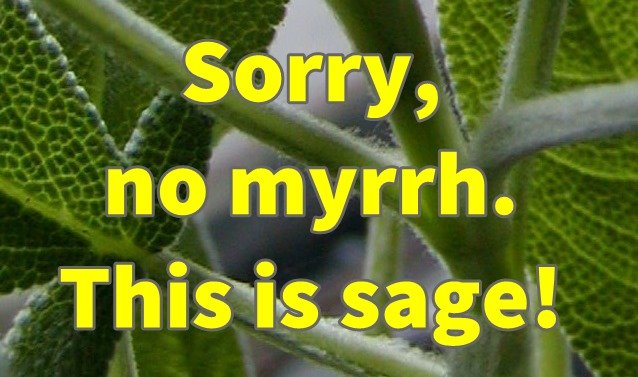Herbs, Trees & Bushes Used in Aromatherapy (Part 2 of 3) 芳香療法所使用的二十一種藥用草類和樹木(備考筆記)
The next eleven plants are: neroli 橙花, pepper, black 黑胡椒, peppermint 胡椒薄荷, primrose, evening 月見草, rosemary 迷迭香, rosewood 花梨木, sage 鼠尾草, Saint John’s wort 聖約翰草, tea tree 茶樹, wintergreen 白珠樹, ylang-ylang 依蘭

Notice the fine hairs on the sage stems (鼠尾草 “mouse tail herb” in Chinese) in this Public Domain photograph. See #17 for more details.
See Part 1 for an explanation of my conventions for presenting information: https://steemit.com/education/@wentong-syhhae/herbs-trees-and-bushes-used-in-aromatherapy-part-1-of-3
11 # neroli (orange blossom)
/ˈnɛrəli/ # 橙花 chénghuā / chernghua # {orange+ blossom} 英文『花』分兩種:
blossom(樹上) & flower(其他植物)
L. Citrus aurantium var amara /ˈtʃitrus aʊˈrɑntium aˈmara/# Used by the Princess of Nerola, Italy, hence the name “neroli” (same genus Citrus and species aurantium “orange” as “bergamot” # 2, different variety: amara = “bitter”
12 # pepper, black
/blæk ˈpɛpɚ/ # 黑胡椒 hēi+ hú+ jiāo / hei+ hwu+ jiau # {black+ foreign+ pepper}
L. Piper nigrum /ˈpipɛr ˈnigrum/ # {pepper+ black} (Spanish negro = “black”)
13 # peppermint
/ˈpɛpɚˌmint/ # 胡椒薄荷 hújiāo+ bòhé / hwujiau+ bohher # {pepper+ mint}
*# Mentha piperita /ˈmɛnta pipɛˈrita/ # mint, pepper-like {薄荷, 類似胡椒的}
14 # primrose, Evening
/ˈivnɩŋ ˈprɩmroʊz/ # 月見草 為什麼叫 yuèjiàncǎo / yuehjianntsao “the herb that sees the moon” # This flower blooms at night, hence the name (38 second video):
# Oenothera biennis /ɛnoˈtɛra biˈɛnis/ # bi- “two”, ennis - year = biennial, a plant that lives for two years
15 # rosemary
/ˈroʊzməri/ or /ˈroʊzˌmɛri/ # 樟腦迷迭香 zhāngnǎo mídiéxiāng / jangnao midyeshiang
# Rosmarinus officinalis/rosmaˈrinus ofitʃiˈnalis/ CT “camphor” /kæmfɚ/ (CT似乎指『栽培變種』) # Ros “dew” marinus “sea”. Rosemary is a hardy plant that grows by the seaside. 海邊露水 # officinalis 正式登記為藥草
16 # rosewood
/ˈroʊzwʊd/ # 花梨木 huā+ lí+ mù / hua+ li+ muh # flower+ pear+ wood (referring to its pleasant fragrance) # Aniba roseodora /aˈniba ˌrosɛoˈdora/ # roseodora 有玫瑰般的香氣
17 # sage, clary
/ˈklæri seɩʤ/ # 快樂鼠尾草kuàilè+ shǔwěi+ cǎo / kuayleh+ shuuwoei+ tsao. The Chinese translation for “Clary” shows the unique Chinese genius for simultaneously expressing two ideas with one word. “Clary” expresses both (1) a sound {KuàiLè = C_La(ry)} and (2) a meaning “happy”} (Clary sage can be used to relieve symptoms of sadness, anxiety and depression) # {“happy+ mouse+ tail+ herb” [the hairy stems resemble rodent tails]} # L. Salvia sclarea /ˈsalvia sklaˈrɛa/ salvia is related to the English words safe, salvation and salute (originally: “May you be healthy!”, still used in Fr, Sp & It) # Knowing that u~v~f are very similar sounds also helps you recognize these etymologically related words: salvia= “the life-saving herb” 健康, safe (f~v) 安全. sage 可以解釋為『救人的植物. ~ salute(敬禮本意:祝福對方身體健康)
18 # Saint John’s wort
/seɩnt ˈʤɑnz ˌwɔrt/ # 聖約翰草 shèng+ yuēhàn cǎo / shenq+ iuehann tsao # The Chinese form of “John” is two syllables (約翰), similar to German “Johann”. More information here: https://www.quora.com/Why-is-the-Chinese-translation-of-John-yue-han/answer/Robert-Matthews-%E9%A6%AC%E5%AD%B8%E9%80%B2 #
L. Hypericum perforatum # Hypericum [unclear]
perforatum leaves contain translucent dots # Named after St. John the Baptist (wort = plant). More information: http://www.herballegacy.com/Nelson_History.html
19 # tea tree
/ˈtiˌtri/ # 茶樹 cháshù / charshuh # 茶樹 = “tea+ tree” #
Mela+leuca, alterni+folia /mɛlaˈluka alterniˈfolia/ {black+white, alternate+leaves} # 黑白交替葉片. melan+in 黑+素. leuk+em+ia (white+blood+disease) 白+血+病
20 # wintergreen
/ˈwɩntɚˌgrin/ # 白珠樹(冬青)báizhūshù (dōngqīng) / bairjushuh (dongching) # “winter+green” #
Gaultheria procumbens /gaʊlˈtɛria proˈkumbɛns/ # L. procumbens “lying on the ground” (this plant does not grown very tall)
Related, but uncommon English words: 1. recumbent /riˈkʌmbənt/ “lying down” & 2. incumbent /ɩnˈkʌmbənt/ “holding a government office” (the incumbent mayor 現任市長)
21 # Ylang Ylang
/ˌilaŋˈilaŋ/ # 依蘭 yīlán / ilan # #
Cananga odorata # kenanga (Indonesian name), ilang-ilang (Tagalog) = "wilderness". L. odorata = fragrant
Resteemed your article. This article was resteemed because you are part of the New Steemians project. You can learn more about it here: https://steemit.com/introduceyourself/@gaman/new-steemians-project-launch
@cryptohustlin has voted on behalf of @minnowpond. If you would like to recieve upvotes from minnowpond on all your posts, simply FOLLOW @minnowpond. To be Resteemed to 4k+ followers and upvoted heavier send 0.25SBD to @minnowpond with your posts url as the memo
@mrainp420 has voted on behalf of @minnowpond. If you would like to recieve upvotes from minnowpond on all your posts, simply FOLLOW @minnowpond. To be Resteemed to 4k+ followers and upvoted heavier send 0.25SBD to @minnowpond with your posts url as the memo
@originalworks
The @OriginalWorks bot has determined this post by @wentong-syhhae to be original material and upvoted it!
To call @OriginalWorks, simply reply to any post with @originalworks or !originalworks in your message!
To enter this post into the daily RESTEEM contest, upvote this comment! The user with the most upvotes on their @OriginalWorks comment will win!
For more information, Click Here!
Special thanks to @reggaemuffin for being a supporter! Vote him as a witness to help make Steemit a better place!